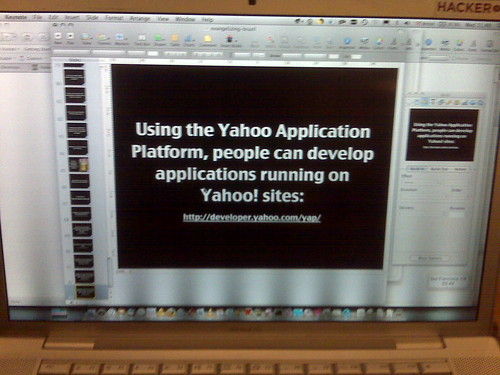A few things the web development community can learn from The Green Movie
Thursday, March 12th, 2009One of the, oh heck, the only really good thing about flying Delta was their Fly-in-Movie competition. This is a section of their entertainment program where they show short movies of budding movie makers who compete to be shown at the Tribeca Film Festival in New York this coming April.
The green film
One of the movies in there is The Green Film and I loved it (“Cold call” was also very good).
In this 6 minute movie a self-righteous film director proclaims pompously and full of enthusiasm that they are producing the greenest movie ever. All the food is organic, everything gets recycled, all the make-up is free of animal testing and there is not a single thing that is not in the correct order and would cause a frown on the faces of the friends of the earth.
The wrong doers and how they should be lectured
When the main actress arrives she rolls up in a stretch limo and asks for her trailer. The director tells her off for not cycling or using a bus and shows her a deck chair and an umbrella which is to be her “trailer”. He goes on to explain all the bad things that do not happen on his set and especially goes into a detailed sermon over plywood used on other sets and that it actually is based on rainforest wood. He also is very insightful about using the right light bulbs on the whole set.
Getting caught out
The actress on the other hand starts wondering about the professionalism of the whole setup – which culminates in her wondering if the movie is shot on film rather than digital. The director then goes nuts on the mere idea of movies being shot in digital and that digital film is just “TV on big screens”. His rant goes so far as to proclaim that art could never be done with digital cameras. To the arguments of the actress about film processing involving toxic chemicals and shipment of reels all over the world the only thing the director comes up with is “but we recycle – a lot!”.
The movie ends with the actress filming herself in the woods using her mobile (cellphone for Americans).
How this applies to us
This is exactly how we get stuck when advocating best practices on the web. One interesting exchange that shows this is Chromatic Sites advocating for CSS vs. Table layouts and Mike Davies shining a massive big light of truth on the arguments provided.
Another interesting “oh not again” moment was Jeffrey Zeldman doing the inaugural testing of the top 100 sites in a validator causing an avalanche of comments.
You know what? We’re wasting time and energy in these discussions and we are so immersed in our own “doing the right thing” that we forgot to care about what we wanted to achieve in the first place. We get into meticulous details of explaining certain technologies and invent idea after idea based on the same technologies we tried to make people understand by force years and years ago and failed.
Standards and best practices are there for a single reason: make our work predictable and easy to work with other developers. This only works if everybody is on board and understands these best practices – in essence, following them needs to make their job easier. If following a “best practice” doesn’t make our lives easier but produces extra overhead it will not catch on.
Instead of concentrating on showing the benefits of working in a predictable manner we concentrate on ticking all the right boxes and telling everybody who is unfortunate enough to listen about all the details we had to think about to get where we are. We know all about the plywood and the right light bulbs but we forgot to talk in the language of the people we want to reach with our ideas. We are not concentrating on how we deliver the message and that there might be better techniques and technologies available nowadays than the great problem solvers of the past.
Web development is evolving and changing to new channels of distribution and re-use. Widget frameworks allow re-use of the same little application across the web, mobile devices and now even Television sets. These things is what we should have our sights on and not if a certain document passes a dumb validation test or not. Validation is the beginning of a quality control process, not the end of it. Semantic value cannot be validated by a dumb machine but needs a human to check. Zeldman did point this out in his introduction to the test, but this message always gets forgotten in the uproar of indignation over and unencoded ampersand.

